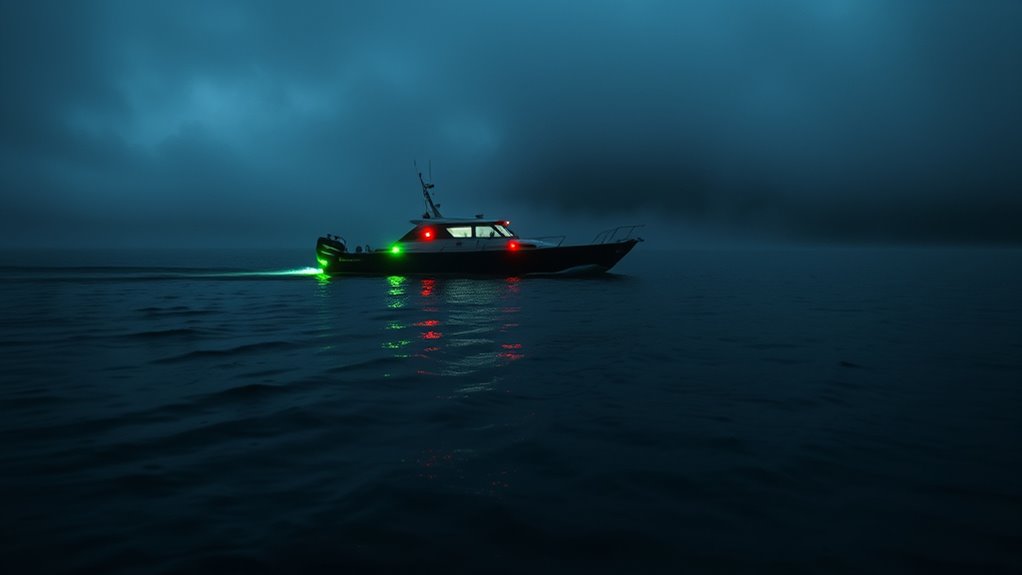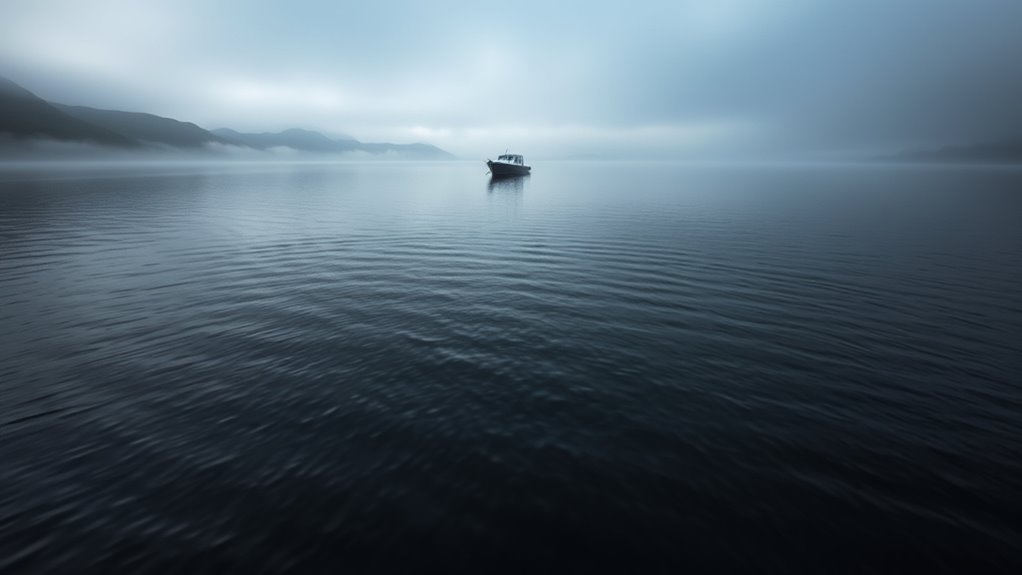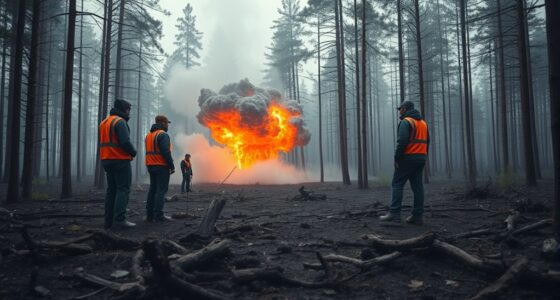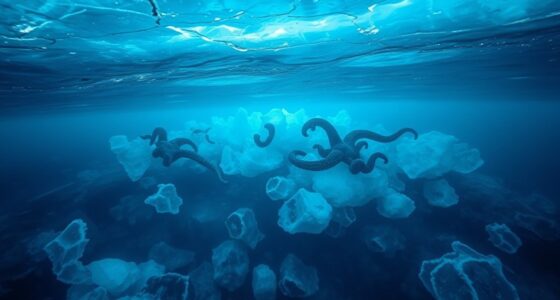Recent sonar searches in Loch Ness have sparked renewed debate about the legendary monster, Nessie. While some signals remain unexplained, no conclusive proof has emerged. The searches highlight ongoing scientific efforts combined with a fascination that’s lasted for decades. Environmental impacts are a concern, but advancements in technology aim to explore responsibly. If you’re curious about the latest discoveries and what they mean for the legend, there’s more to explore below.
Key Takeaways
- Recent sonar scans of Loch Ness detected unexplained signals, reigniting debates about the existence of Nessie.
- Advanced, non-invasive sonar technology continues to explore the loch’s depths while aiming to minimize environmental impact.
- No conclusive proof of Nessie has emerged, but intriguing signals keep the legend alive amid ongoing scientific inquiry.
- Search efforts boost tourism but raise concerns over ecological disruption and habitat disturbance in the sensitive environment.
- The ongoing debate balances the fascination with the legend against the need for responsible, environmentally conscious research.

Nestled deep within the Scottish Highlands, Loch Ness has captured the world’s imagination for centuries with reports of a mysterious creature lurking beneath its dark waters. These cryptid sightings have fueled countless debates, inspiring explorers and skeptics alike to seek answers. Modern technology, like sonar searches, has intensified the intrigue, offering new perspectives on what might dwell beneath the surface. When sonar scans reveal strange, unexplained signals, it reignites speculation about the legendary monster, often called Nessie. Yet, each discovery prompts questions beyond just the creature itself. You might wonder how these searches impact the environment — whether they disturb local wildlife or disrupt the delicate ecosystem of the loch. As teams deploy advanced sonar equipment, they often navigate a fragile balance, aware of the potential environmental impacts of their activities.
The presence of cryptid sightings over the years has created a complex relationship with Loch Ness’s ecosystem. Some argue that increased tourism driven by the legend has both positive and negative effects. On the one hand, it boosts the local economy, bringing in revenue and fostering community pride. On the other, it can lead to pollution, habitat disruption, and stress on local flora and fauna. You might notice that boats, research vessels, and even drone activity disturb the water and shoreline, possibly affecting native species that rely on undisturbed habitats. While these efforts aim to uncover the truth about Nessie, they must be carefully managed to minimize environmental impacts.
Recent sonar searches have produced intriguing signals, but none have conclusively proven the existence of a mysterious creature. Still, these efforts keep the legend alive, sparking debate among scientists, enthusiasts, and skeptics. You’re likely aware that such searches also involve environmental considerations, like avoiding disruption to aquatic life or damaging underwater ecosystems. As technology advances, researchers endeavor to strike a balance, using non-invasive methods to explore the depths while conserving the loch’s natural beauty. You might also consider how environmental impacts of such searches could influence future research approaches. The ongoing debate isn’t just about whether Nessie exists; it also concerns how we conduct our investigations responsibly, respecting both the legend and the environment.
In the end, Loch Ness remains a captivating enigma, blending folklore with scientific inquiry. Your curiosity is piqued not just by the possibility of a mysterious creature but also by the implications of how our quest for answers impacts the natural world around us. As sonar search technology improves, so does our understanding of the delicate environment of Loch Ness, reminding us that every discovery comes with responsibilities. Whether or not Nessie is real, the story continues to evolve, reflecting our fascination with the unknown and our desire to protect the place that fuels that wonder.
Frequently Asked Questions
Has Any Credible Scientific Evidence Ever Confirmed Nessie’s Existence?
You won’t find any credible scientific validation confirming Nessie’s existence. While cryptozoology enthusiasts remain skeptical, rigorous scientific studies, including sonar searches, have yet to produce conclusive evidence. Despite numerous sightings and claims, the lack of verified data keeps the legend in the domain of speculation rather than scientific fact. So, until solid proof emerges, the scientific community continues to doubt Nessie’s existence.
What Are the Most Popular Theories Explaining the Loch Ness Monster?
You might think it’s all just folklore influence, but the most popular theories suggest Nessie is a surviving plesiosaur or a large misidentified creature. Ironically, despite numerous cryptid sightings, skeptics argue it’s just optical illusions or hoaxes. Some believe the legend persists because it captures our imagination, fueling stories that keep the mystery alive. Whether real or not, Nessie remains a enthralling symbol of the unknown lurking beneath the water’s surface.
How Do Local Legends and Folklore Influence the Search Efforts?
Your local legends and folklore, rooted in medieval stories and local beliefs, heavily influence your search efforts. They inspire a sense of mystery and hope, encouraging you to explore Loch Ness with curiosity. These tales shape your expectations and motivate you to use advanced technology, hoping to uncover proof of the monster. The stories create a cultural backdrop that keeps the legend alive, guiding and fueling your ongoing quest.
Have Any Recent Sonar Images Been Conclusively Proven to Be Monsters?
You wonder if recent sonar anomalies or photographic evidence have conclusively proven the monster’s existence. Unfortunately, no. These sonar images often resemble shadows or underwater debris, making them inconclusive. Photographic evidence remains elusive and ambiguous, much like a fleeting shadow in a foggy landscape. While intriguing, these signals are symbols of curiosity rather than proof, keeping the legend alive but unverified by concrete scientific findings.
What Impact Does the Legend Have on Tourism in the Loch Ness Area?
The legend notably boosts tourism in the Loch Ness area, providing an economic boost through visitors enthusiastic to catch a glimpse of the mystery. You’ll find that the myth enhances the area’s cultural identity, attracting tourists who want to experience the folklore firsthand. This ongoing fascination sustains local businesses, from hotels to souvenir shops, ensuring that the legend remains an essential part of the community’s economy and cultural landscape.
Conclusion
So, with over 1,000 sonar scans conducted, the mystery of Loch Ness remains unresolved. You’ve seen how new searches continue to fuel debate, keeping the legend alive. While no definitive proof has emerged, the fact that 90% of sightings still go unexplained keeps enthusiasts hopeful. Maybe one day, technology will finally uncover the truth. Until then, the legend persists, inviting you to wonder what truly lies beneath those mysterious waters.









